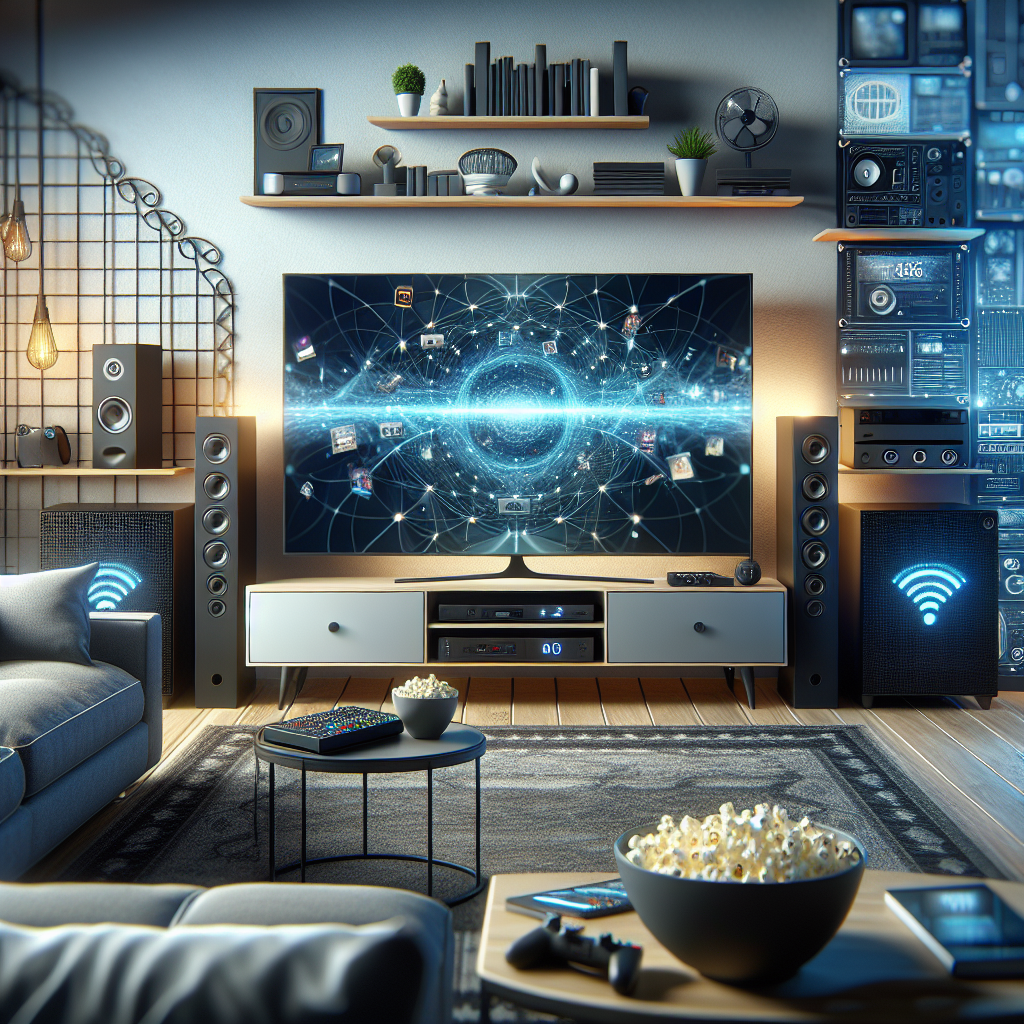In today’s digital age, the world of entertainment has been revolutionized by the wonders of wireless connectivity. With the advancement of technology, the need for tangled cords and limited mobility is now a thing of the past. From smart TVs to gaming consoles, wireless connectivity has transformed the way we interact with our entertainment systems. This innovation allows for seamless streaming, effortless sharing, and unparalleled convenience. Join us as we delve into the endless possibilities and benefits of wireless connectivity for entertainment systems, and discover how this cutting-edge technology is shaping the future of entertainment.
Understanding Wireless Connectivity in Entertainment Systems

Wireless connectivity refers to the technology that allows electronic devices to communicate with each other without the need for physical cables or wires. In the realm of entertainment systems, this type of connectivity plays a crucial role in facilitating seamless interactions between various components, such as TVs, speakers, gaming consoles, and streaming devices.
-
Definition of wireless connectivity:
- Wireless connectivity enables data transfer and communication between devices using radio frequency signals or infrared technology, eliminating the constraints imposed by physical connections.
-
Importance of wireless connectivity in entertainment systems:
- Convenience: Wireless connectivity eliminates the hassle of dealing with tangled cords and cables, providing users with a clutter-free setup.
- Flexibility: With wireless technology, entertainment systems can be easily reconfigured or expanded without the limitations of fixed cable connections.
- Mobility: Users can enjoy their entertainment content from different locations within the wireless range, offering a more dynamic and adaptable viewing experience.
-
Overview of how wireless technology revolutionizes entertainment setups:
- Streaming Capabilities: Wireless connectivity enables seamless streaming of audio and video content from various online platforms, enhancing the accessibility of entertainment options.
- Multi-Room Audio: With wireless speakers and sound systems, users can create a synchronized audio experience across different rooms in their home without the need for extensive wiring.
- Smart Home Integration: Wireless connectivity allows entertainment systems to integrate with other smart devices, enabling users to control their entertainment setup through voice commands or mobile apps.
Types of Wireless Connectivity Technologies
1. Wi-Fi
Wi-Fi technology, short for Wireless Fidelity, enables devices to connect to the internet and communicate wirelessly using radio frequencies. It has become a staple in modern entertainment systems for its convenience and versatility. Here are some key points to consider:
-
Explanation of Wi-Fi technology: Wi-Fi works by transmitting data through radio waves between a wireless router and connected devices. It allows for seamless streaming of music, movies, and online content to TVs, speakers, and other entertainment devices without the need for physical cables.
-
Benefits of using Wi-Fi in entertainment systems:
- Convenience: Wi-Fi eliminates the clutter of cables, providing a clean and streamlined setup for entertainment systems.
- Flexibility: Users can easily move devices around within the range of the Wi-Fi network without worrying about cable lengths or connections.
-
Accessibility: Wi-Fi enables multiple devices to connect to the same network, allowing for shared access to media libraries and online content.
-
Limitations of using Wi-Fi in entertainment systems:
- Interference: Wi-Fi signals can be affected by obstacles, distance from the router, and other electronic devices operating on the same frequency, leading to potential signal disruptions.
- Bandwidth limitations: While modern Wi-Fi standards offer high-speed connections, the bandwidth is shared among connected devices, which can result in slower speeds during peak usage times.
-
Security concerns: Wi-Fi networks can be vulnerable to hacking and unauthorized access if not properly secured with encryption and strong passwords.
-
Tips for optimizing Wi-Fi connectivity:
- Router placement: Position the router in a central location to ensure a strong signal throughout the entertainment area.
- Signal boosters: Consider using Wi-Fi extenders or mesh network systems to expand coverage and eliminate dead zones.
- Network security: Enable encryption (WPA2) and change default passwords to protect the Wi-Fi network from unauthorized access.
- Update firmware: Regularly update router firmware to ensure optimal performance and security features are up to date.
2. Bluetooth
Overview of Bluetooth Technology
Bluetooth technology is a wireless communication standard that allows for the exchange of data over short distances. It operates on the 2.4 GHz frequency band and is commonly used in entertainment systems to connect devices such as smartphones, speakers, headphones, and gaming consoles. Bluetooth enables seamless connectivity without the need for cables, providing convenience and flexibility in setting up entertainment systems.
Comparison between Wi-Fi and Bluetooth for Entertainment Systems
When considering connectivity options for entertainment systems, Bluetooth and Wi-Fi serve different purposes. While Wi-Fi offers a broader range and higher data transfer speeds, Bluetooth is preferred for its simplicity and energy efficiency. In entertainment setups where multiple devices need to communicate over short distances, Bluetooth is often the preferred choice due to its ease of use and compatibility with a wide range of devices.
Practical Applications and Compatibility of Bluetooth in Entertainment Setups
Bluetooth technology is extensively used in entertainment systems for various applications. It allows for wireless streaming of audio from smartphones to speakers, eliminating the need for physical connections. Bluetooth headphones provide users with a wire-free listening experience, enhancing comfort and mobility. Additionally, gaming consoles utilize Bluetooth controllers for a seamless gaming experience without tangled cords. The compatibility of Bluetooth across different devices makes it a versatile option for integrating various components within entertainment setups.
3. Wireless HDMI
Wireless HDMI technology facilitates the transmission of high-definition audio and video signals wirelessly from a source device to a display, without the need for physical cables. This technology operates on the 5 GHz frequency band and offers seamless connectivity for a clutter-free entertainment setup.
Understanding Wireless HDMI technology:
– Wireless HDMI utilizes radio frequency to transmit uncompressed audio and video signals, providing a high-quality viewing experience.
– It typically consists of a transmitter that connects to the source device and a receiver that links to the display, ensuring a reliable connection within a certain range.
Advantages of using Wireless HDMI in entertainment systems:
– Eliminates the need for long cables, reducing clutter and offering greater flexibility in positioning devices within a room.
– Enables seamless streaming of content from various sources, such as gaming consoles, Blu-ray players, and set-top boxes, to the display without compromising on picture and sound quality.
– Supports high-definition formats, including 4K Ultra HD and 3D, delivering an immersive entertainment experience without the limitations of physical connections.
Considerations when choosing Wireless HDMI for optimal performance:
– Compatibility: Ensure that the source device and display support Wireless HDMI technology for seamless integration.
– Interference: Be mindful of potential signal interference from other wireless devices operating on the same frequency band to maintain a stable connection.
– Range: Consider the transmission range of the Wireless HDMI system to ensure it covers the required distance between the source and the display for uninterrupted streaming.

Setting Up Wireless Connectivity in Entertainment Systems
1. Choosing the Right Equipment
Setting Up Wireless Connectivity in Entertainment Systems
When it comes to setting up wireless connectivity in entertainment systems, selecting the right equipment is crucial for a seamless experience. Here are some key considerations and recommendations to keep in mind:
-
Factors to consider when selecting wireless connectivity devices:
- Compatibility: Ensure that the wireless connectivity devices you choose are compatible with your existing entertainment system components, such as TVs, speakers, and gaming consoles.
- Range: Consider the range of the wireless signal to ensure optimal coverage throughout your entertainment space without any dead zones.
- Bandwidth: Look for devices that support high bandwidth to accommodate streaming high-definition content without any lag or buffering issues.
- Interference: Check for potential sources of interference, such as other electronic devices or physical barriers, and select devices that can mitigate these challenges.
- Ease of setup: Opt for user-friendly devices that are easy to set up and configure, minimizing any technical difficulties during installation.
-
Recommended brands and models for reliable wireless connections:
- Google Chromecast: Known for its simplicity and versatility, Chromecast offers seamless streaming from various devices to your TV.
- Sonos Wireless Speakers: Sonos speakers provide excellent sound quality and multi-room connectivity options for a premium audio experience.
- TP-Link Deco Mesh Wi-Fi System: Ideal for eliminating Wi-Fi dead zones, this mesh system offers reliable and consistent wireless coverage throughout your home.
- Apple AirPlay: For Apple users, AirPlay enables effortless streaming of music, videos, and photos to compatible devices for a streamlined entertainment experience.
By carefully considering these factors and exploring reputable brands and models, you can set up a wireless connectivity system for your entertainment setup that enhances your viewing, listening, and gaming experiences.
2. Installation and Configuration
Setting up wireless connectivity in entertainment systems requires a systematic approach to ensure seamless operation. Here is a detailed breakdown of the installation and configuration process:
- Assessing the Environment:
-
Before beginning the installation, evaluate the layout of the space where the entertainment system will be set up. Consider the distance between devices and potential sources of interference such as walls or other electronic devices.
-
Selecting the Right Equipment:
-
Choose wireless connectivity devices that are compatible with your entertainment system components. Ensure that the router or access point supports the latest wireless standards for optimal performance.
-
Connecting the Devices:
-
Start by connecting the wireless router or access point to the modem using an Ethernet cable. Power on the devices and follow the manufacturer’s instructions to configure the wireless network settings.
-
Configuring Network Settings:
-
Access the router’s admin panel through a web browser using the provided IP address. Set up a unique network name (SSID) and password to secure the wireless connection. Enable encryption such as WPA2 for enhanced security.
-
Connecting Entertainment Devices:
-
For each entertainment device, navigate to the wireless settings menu and scan for available networks. Select the network name you configured earlier and enter the password when prompted. Once connected, test the connection to ensure proper functionality.
-
Optimizing Signal Strength:
-
Position the wireless router or access point in a central location to maximize signal coverage. Avoid placing the device near metal objects or large appliances that could interfere with the signal. Consider using wireless repeaters or extenders to boost signal strength in larger spaces.
-
Testing and Troubleshooting:
- After completing the setup, test the wireless connection on each entertainment device to verify connectivity. If you encounter any issues such as slow speeds or dropped connections, troubleshoot by checking signal strength, resetting devices, or adjusting network settings as needed.
By following these steps diligently, you can ensure a smooth installation and configuration process for wireless connectivity in entertainment systems.
Enhancing Entertainment Experiences with Wireless Connectivity
Wireless connectivity has revolutionized the way we engage with entertainment systems, offering a multitude of benefits that enhance our overall experience. From streaming services to gaming and smart devices, the integration of wireless technology has opened up a world of possibilities for entertainment enthusiasts.
Benefits of Wireless Connectivity for Entertainment Systems
-
Seamless Streaming: Wireless connectivity allows for uninterrupted streaming of content across various devices. Whether you’re binge-watching your favorite series or enjoying a movie marathon, the absence of cables ensures a smooth viewing experience.
-
Gaming Without Limits: Gamers can now immerse themselves in virtual worlds without being tethered to a console or PC. Wireless controllers and headsets provide freedom of movement, enhancing gameplay and overall enjoyment.
-
Smart Device Integration: Wireless connectivity enables seamless integration with smart devices, creating a connected ecosystem within your entertainment setup. From voice-controlled assistants to smart lighting and thermostats, the possibilities are endless.
How Wireless Connectivity Improves Convenience and Flexibility
-
Mobility: With wireless connectivity, you can easily move devices around your entertainment space without the hassle of tangled cables. This flexibility allows for customizable setups based on your preferences.
-
Multi-Room Audio: Wireless speakers and sound systems offer the convenience of playing music in multiple rooms simultaneously. Whether you’re hosting a party or simply relaxing at home, wireless audio adds a new dimension to your entertainment experience.
-
Remote Access: Wireless connectivity enables remote access to your entertainment systems, allowing you to control them from anywhere in the house. Adjusting volume, switching between playlists, or even queuing up a movie can be done with the touch of a button on your smartphone or tablet.
Future Trends in Wireless Technology for Entertainment Systems
-
5G Integration: The rollout of 5G technology promises faster internet speeds and lower latency, paving the way for enhanced streaming quality and real-time gaming experiences.
-
IoT Integration: The Internet of Things (IoT) will further revolutionize entertainment systems by enabling seamless communication between devices. Imagine your smart TV syncing with your smart home devices to create a personalized entertainment environment.

– AI Advancements: Artificial intelligence will play a significant role in optimizing wireless connectivity for entertainment systems. AI-powered algorithms can anticipate user preferences, optimize network performance, and enhance overall user experience in ways we have yet to imagine.
Addressing Security Concerns with Wireless Connectivity
1. Securing Your Network
Wireless connectivity in entertainment systems often involves the transmission of personal data and sensitive information, making it imperative to prioritize network security measures. Securing your network is crucial to safeguard against potential cyber threats and unauthorized access. Here are some key points to consider in ensuring the security of your wireless entertainment system network:
-
Implement Strong Encryption: Utilize advanced encryption protocols such as WPA3 to encrypt data transmitted over the network, making it harder for malicious actors to intercept and exploit sensitive information.
-
Enable Network Authentication: Set up strong authentication methods like WPA2-Enterprise or WPA3-SAE to verify the identity of devices attempting to connect to the network, preventing unauthorized access.
-
Change Default Settings: Modify default network settings, including passwords and network names, to reduce the risk of cyber attacks targeting common vulnerabilities in out-of-the-box configurations.
-
Regularly Update Firmware: Keep the firmware of your wireless router and connected devices up to date to patch known security vulnerabilities and ensure optimal protection against emerging threats.
-
Utilize Network Segmentation: Separate your entertainment system network from other devices on the same network through network segmentation to contain potential security breaches and limit the impact of a compromised device.
-
Monitor Network Activity: Use network monitoring tools to track and analyze network activity, enabling you to identify unusual behavior or potential security breaches promptly.
-
Employ Firewall Protection: Activate firewalls on your router and devices to filter incoming and outgoing network traffic, adding an extra layer of defense against unauthorized access and malicious content.
By following these best practices and implementing robust security measures, you can enhance the protection of your wireless network in entertainment systems and enjoy a safer and more secure digital experience.
2. Encryption and Data Privacy
Wireless connectivity for entertainment systems relies heavily on encryption protocols to ensure the security of data being transmitted over the network. Understanding different encryption methods is crucial in safeguarding wireless connections against potential threats and unauthorized access. Here are some key points to consider regarding encryption and data privacy:
- Encryption Protocols:
- Utilize advanced encryption standards such as WPA2 (Wi-Fi Protected Access 2) or WPA3 to secure wireless networks.
- Implement strong, unique passwords for Wi-Fi networks to prevent unauthorized access.
-
Regularly update encryption settings and firmware to address any security vulnerabilities.
-
Data Privacy Measures:
- Enable network encryption for all devices connected to the wireless network to protect sensitive information.
- Consider using virtual private networks (VPNs) for an added layer of security when accessing entertainment content over wireless connections.
- Be cautious when connecting to public Wi-Fi networks, as they may lack sufficient encryption measures, putting your data at risk.
By prioritizing encryption and data privacy measures, users can enjoy the wonders of wireless connectivity for entertainment systems without compromising the security of their information.
FAQs: Exploring the Wonders of Wireless Connectivity for Entertainment Systems
What is wireless connectivity for entertainment systems?
Wireless connectivity for entertainment systems refers to the ability for devices such as TVs, speakers, gaming consoles, and streaming devices to connect to each other without the need for cords or cables. This allows for a more convenient and clutter-free setup in your home entertainment system.
How can I connect my entertainment devices wirelessly?
There are several ways to connect your entertainment devices wirelessly, such as through Wi-Fi, Bluetooth, or infrared technology. Wi-Fi is commonly used for streaming devices and smart TVs, while Bluetooth is often used for connecting speakers and headphones. Some devices also come with built-in infrared technology for remote control.
What are the benefits of using wireless connectivity for entertainment systems?
Using wireless connectivity for your entertainment systems offers you more flexibility and convenience in how you set up and use your devices. It allows you to easily move your devices around your home without being restricted by cords and cables. Furthermore, wireless connections can provide a more seamless and streamlined user experience.
Are there any drawbacks to using wireless connectivity for entertainment systems?
While wireless connectivity offers many benefits, there are also some drawbacks to consider. Wireless connections can sometimes be less reliable than wired connections, leading to potential lag or interruptions in your entertainment experience. Additionally, wireless signals can be affected by interference from other devices or obstacles in your home.
How can I improve the wireless connectivity of my entertainment system?
To improve the wireless connectivity of your entertainment system, you can try positioning your devices closer to your router, using a Wi-Fi range extender, or investing in a higher-quality router with better signal strength. You can also ensure that your devices are updated with the latest firmware and that there is minimal interference from other devices in your home.